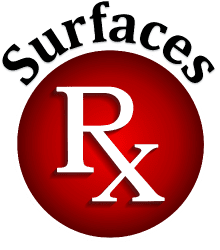Everyday Steps, Steps When Someone is Sick, and Considerations for Employers
How to clean and disinfect
Clean
Clean surfaces using soap and water. Practice routine cleaning of frequently touched surfaces.
High touch surfaces include:
Tables, doorknobs, light switches, countertops, handles, desks, phones, keyboards, toilets, faucets, sinks, etc.
Disinfect
- Clean the area or item with soap and water or another detergent if it is dirty. Then, use disinfectant.
- Recommend use of EPA-registered household disinfectantexternal icon.
Follow the instructions on the label to ensure safe and effective use of the product.
Many products recommend:- Keeping surface wet for a period of time (see product label)
- Precautions such as wearing gloves and making sure you have good ventilation during use of the product.
- Diluted household bleach solutions may also be used if appropriate for the surface. Check to ensure the product is not past its expiration date. Unexpired household bleach will be effective against coronaviruses when properly diluted.
Follow manufacturer’s instructions for application and proper ventilation. Never mix household bleach with ammonia or any other cleanser.
Leave solution on the surface for at least 1 minute
To make a bleach solution, mix: - 5 tablespoons (1/3rd cup) bleach per gallon of water
OR - 4 teaspoons bleach per quart of water
- 5 tablespoons (1/3rd cup) bleach per gallon of water
- Alcohol solutions with at least 70% alcohol.
Soft surfaces
For soft surfaces such as carpeted floor, rugs, and drapes
- Clean the surface using soap and water or with cleaners appropriate for use on these surfaces.
- Launder items (if possible) according to the manufacturer’s instructions.Use the warmest appropriate water setting and dry items completely.
OR - Disinfect with an EPA-registered household disinfectant. That meet EPA’s criteria for use against COVID-19.
Electronics
For electronics, such as tablets, touch screens, keyboards, remote controls, and ATM machines
- Consider putting a wipe-able cover on electronics.
- Follow manufacturer’s instruction for cleaning and disinfection.
- If no guidance, use alcohol-based wipes or sprays containing at least 70% alcohol. Dry surface thoroughly.
Laundry
For clothing, towels, linens and other items
- Launder items according to the manufacturer’s instructions. Use the warmest appropriate water setting and dry items completely.
- Wear disposable gloves when handling dirty laundry from a person who is sick.
- Dirty laundry from a person who is sick can be washed with other people’s items.
- Do not shake dirty laundry.
- Clean and disinfect clothes hampers according to guidance above for surfaces.
- Remove gloves, and wash hands right away.
Cleaning and disinfecting your building or facility if someone is sick
- Close off areas used by the person who is sick.
- Open outside doors and windows to increase air circulation in the area. Wait 24 hours before you clean or disinfect. If 24 hours is not feasible, wait as long as possible.
- Clean and disinfect all areas used by the person who is sick, such as offices, bathrooms, common areas, shared electronic equipment like tablets, touch screens, keyboards, remote controls, and ATM machines.
- If more than 7 days since the person who is sick visited or used the facility, additional cleaning and disinfection is not necessary.
- Continue routing cleaning and disinfection.
When Cleaning
- Wear disposable gloves and gowns for all tasks in the cleaning process, including handling trash.
- Additional personal protective equipment (PPE) might be required based on the cleaning/disinfectant products being used and whether there is a risk of splash.
- Gloves and gowns should be removed carefully to avoid contamination of the wearer and the surrounding area.
- Wash your hands often with soap and water for 20 seconds.
- Always wash immediately after removing gloves and after contact with a person who is sick.
- Hand sanitizer: If soap and water are not available and hands are not visibly dirty, an alcohol-based hand sanitizer that contains at least 60% alcohol may be used. However, if hands are visibly dirty, always wash hands with soap and water.
- Additional key times to wash hands include:
- After blowing one’s nose, coughing, or sneezing.
- After using the restroom.
- Before eating or preparing food.
- After contact with animals or pets.
- Before and after providing routine care for another person who needs assistance (e.g., a child).
